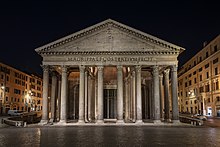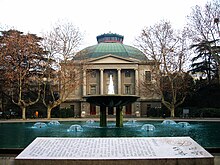The Roman Pantheon Explained
The Pantheon 古羅馬萬神殿:哈德良118~128...米開蘭基羅的話Disegno angelico e non umano;拉菲爾的墓;林懷民2014年的明信片......
https://www.facebook.com/hanching.chung/videos/1518568421966238
.....
Studying Roman concrete could help engineers today. Increasing concrete’s lifespan would mean less repair and renovation was needed, helping buildings last longer. Read how: https://econ.trib.al/GqmGA2F
Image: Pigi Cipelli/The New York Times / Redux / eyevine

****
Roman concrete is known to defy the centuries without losing much of its firmness. How this happens is only now coming to light

ECONOMIST.COM
Roman civil engineering has lessons for the modern world
***
https://en.wikipedia.org/wiki/Panth%C3%A9on
The Panthéon (French: [pɑ̃.te.ɔ̃], from the Classical Greek word πάνθειον, pántheion, '[temple] to all the gods')[1] is a monument in the 5th arrondissement of Paris, France. It stands in the Latin Quarter, atop the Montagne Sainte-Geneviève, in the centre of the Place du Panthéon, which was named after it. The edifice was built between 1758 and 1790, from designs by Jacques-Germain Soufflot, at the behest of King Louis XV of France; the king intended it as a church dedicated to Saint Genevieve, Paris' patron saint, whose relics were to be housed in the church. Neither Soufflot nor Louis XV lived to see the church completed.
| Panthéon | |
|---|---|
 The Panthéon seen from Tour Montparnasse |
Interment in the crypt is severely restricted and is allowed only by a parliamentary act for "National Heroes". Similar high honours exist in Les Invalides for historical military leaders such as Napoléon, Turenne and Vauban.
----
張谷若 網路緣:萬神殿是天使建造的;哈代『無名的裘德』、嘉德橋市長
1999年9月,我寫篇介紹萬神殿的文章。提出一句卷末的意大利文,我不懂,向可能的讀者求教。 也許兩年之後,一位年青朋友說:
『針對1999/09《The Pantheon》以米開蘭基羅的話Disegno angelico e non umano(有人知道此句請賜知)這句話,我在另一網站有看到其解釋,「這是天使建造的」, 特提出以提供參考。from:小葉的窩』
2004/12/13 我再訪http://www.taconet.com.tw/bogod 的「古老的傳說」,知道是葉高雄先生的網址。【 萬神殿是古羅馬建築中,品質最佳、保存得最完整的建築物。 這是為了祭祀萬神,於西元前27年,由阿格利帕興建的。 其後於119-128年,哈德連皇帝將之修改為現今的模樣。 據傳,當米開朗基羅見到這座教堂時,不禁發出「這是天使建造的」 的感言。走進萬神殿,每個人的目光都會被圓頂的大洞所吸引。 此洞稱為「眼」,直徑9公尺,是由外部取光,殿內唯一的窗戶。 大圓頂的直徑43.3公尺, 比聖彼得大教堂42公尺的圓頂略勝一籌。義大利統一後, 萬神殿成為國王的陵墓所在,除此, 還埋葬一些偉大的義大利的藝術家,其中以拉斐爾最著名。】
1999年,我可能還不懂得google(可能也不會中文打字),所以不會上網查The Pantheon http://gnv.fdt.net/~aabbeama/ Christmas/Pantheon.html
RL's inputs:
re: Disegno angelico e non umano
disegno = drawing ; outline, design, scheme
angelico → angèlico = cherubic
e = and, plus
non = no, not
umano = human; humanely
***2021.5.26
Disegno angelico e non umano
Google翻譯:Angelic and non-human design
| Church of St. Mary of the Martyrs | |
|---|---|
Chiesa Santa Maria dei Martiri Sancta Maria ad Martyres | |
 The tomb of Raphael |
***Wikipedia
https://en.wikipedia.org/wiki/Pantheon,_Rome
| Pantheon | |
|---|---|
 | |
| Location | Regio IX Circus Flaminius |
| Built in | 113–125 AD (current building) |
| Built by/for | Trajan, Hadrian |
| Type of structure | Roman temple |
| Related | Marcus Vipsanius Agrippa, Hadrian, Apollodorus of Damascus |
The Pantheon (UK: /ˈpænθiən/, US: /-ɒn/;[1] Latin: Pantheum,[nb 1] from Greek Πάνθειον Pantheion, "[temple] of all the gods") is a former Roman temple and since the year 609 a Catholic church (Basilica di Santa Maria ad Martyres or Basilica of St. Mary and the Martyrs), in Rome, Italy, on the site of an earlier temple commissioned by Marcus Agrippa during the reign of Augustus (27 BC – 14 AD). It was rebuilt by the emperor Hadrian and probably dedicated c. 126 AD. Its date of construction is uncertain, because Hadrian chose not to inscribe the new temple but rather to retain the inscription of Agrippa's older temple, which had burned down.[2]
The building is cylindrical with a portico of large granite Corinthian columns (eight in the first rank and two groups of four behind) under a pediment. A rectangular vestibule links the porch to the rotunda, which is under a coffered concrete dome, with a central opening (oculus) to the sky. Almost two thousand years after it was built, the Pantheon's dome is still the world's largest unreinforced concrete dome.[3] The height to the oculus and the diameter of the interior circle are the same, 43 metres (142 ft).[4]






沒有留言:
張貼留言